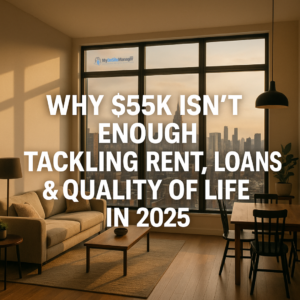For many young professionals, earning $55,000 per year used to feel like a decent starting point. But today, even with that salary, many find themselves struggling to stay afloat financially. The cost of living continues to outpace wage growth, leaving many Americans juggling rent, student loans, and basic living expenses all while barely making it from one paycheck to the next.
This isn’t just a story about one individual it’s a reflection of a much larger financial crisis facing millions.
The Cost Breakdown: Where Does the Money Go?
Let’s take a closer look at how someone earning $55,000 annually might spend their money:
-
Take-Home Pay (after taxes, healthcare, etc.): ~$3,500/month
-
Rent: $1,850/month (more than 50% of take-home pay)
-
Student Loans: $300/month
-
Remaining for all other expenses: ~$1,350/month
With just $1,350 left to cover groceries, utilities, transportation, insurance, healthcare, savings, and personal expenses, it’s easy to see how quickly finances get stretched thin.
The financial advice often touted like the 50/30/20 rule (50% for needs, 30% for wants, 20% for savings) simply isn’t realistic when housing alone consumes more than half of your income.
The Growing Affordability Gap
Housing costs have skyrocketed in recent years:
-
According to Zillow, renters now need to earn around $80,000 a year to live comfortably a significant jump from $60,000 just five years ago.
-
The average new car price sits around $48,800, while even a used vehicle can cost nearly $30,500.
-
Add in rising utility costs, insurance premiums, and healthcare expenses, and it’s no wonder so many are financially squeezed.
These numbers illustrate that it’s not poor financial management causing the struggle it’s a systemic issue of stagnant wages failing to keep up with the rising cost of basic necessities.
Why It’s So Difficult to Get Ahead
Even for those who budget carefully, several factors make financial stability elusive:
-
High Housing Costs: Rent prices have grown far faster than wages, especially in major metropolitan areas.
-
Student Loan Debt: Monthly loan payments further strain limited budgets.
-
Inflation: Everyday essentials like groceries, gas, and utilities have all seen price hikes.
-
Lack of Emergency Savings: With so little left over each month, building an emergency fund feels impossible.
The result? Millions of Americans are one unexpected expense away from financial crisis.
Practical Strategies to Escape the Paycheck-to-Paycheck Cycle
While the challenges are significant, there are still steps individuals can take to create some financial breathing room:
Reduce Housing Costs
-
Find a roommate: Sharing rent and utilities can immediately cut housing expenses by 30-50%.
-
Relocate to a more affordable area: Even a modest drop in rent can have a meaningful long-term impact.
-
Negotiate your rent: Long-term tenants with a solid payment history may have some leverage with landlords.
Build an Emergency Fund
-
Start with a small goal of $1,000 in a high-yield savings account.
-
Work toward saving 3-6 months’ worth of expenses over time to create a safety net.
Increase Income Streams
-
Ask for a raise: Use your performance history and local salary data to negotiate.
-
Look for better job opportunities: Often, switching jobs results in a larger pay bump than internal raises.
-
Explore side hustles: Freelancing, consulting, tutoring, or gig work can supplement your income.
Cut Unnecessary Spending
-
Audit your subscriptions and memberships eliminate anything unused.
-
Cook at home more often to reduce dining expenses.
-
Use apps and loyalty programs for discounts on groceries and gas.
Manage Debt Proactively
-
Refinance or consolidate student loans where possible to reduce interest rates.
-
Pay more than the minimum when possible to reduce principal faster.
The Mental and Emotional Toll
Beyond the financial strain, living paycheck-to-paycheck takes a heavy emotional toll:
-
Constant stress: Worrying about money becomes a daily burden.
-
Limited future planning: Saving for retirement, buying a home, or starting a family feels out of reach.
-
Reduced quality of life: The stress of financial instability impacts physical and mental health.
It’s not just about dollars and cents it’s about peace of mind, stability, and long-term security.
The Bigger Systemic Issue
At its core, this problem reflects a broader systemic failure:
-
Wages have stagnated for decades while housing, education, and healthcare costs have ballooned.
-
Student loan burdens continue to weigh down younger generations.
-
Financial education is still lacking for many Americans.
Without meaningful policy changes, many individuals will continue to find themselves trapped in this cycle despite working full-time and earning what should, on paper, be a livable salary.
Final Thoughts: You’re Not Alone And There Are Steps Forward
The experience of living paycheck-to-paycheck on $55,000 a year isn’t unusual it’s the norm for millions. And while many of the factors driving this financial squeeze are outside individual control, small steps can still help build some stability.
-
Focus on controllable expenses.
-
Seek ways to increase income.
-
Prioritize building a financial cushion, even if it starts small.
-
Don’t hesitate to seek financial counseling or professional advice.
Most importantly: know that your financial challenges aren’t a personal failure they’re a reflection of much larger forces at work in today’s economy.
Source: Yahoo! Lifestyle – “I make $55,000 – but after rent, student loans and a bit of savings, I’m stuck living paycheck to paycheck”

